
views
- Figs taste best when they’re ripe, raw, and with the seeds and skin intact.
- Wash figs under cold water and gently pat them dry. Remove the stem before eating.
- Check if your fig is ready to eat by squeezing it gently—a ripe fig will feel soft and give a little, but still hold its shape.
What’s the best way to eat a fig?

Figs taste best when they’re soft, ripe, and in season. The exact size and color of a ripe fig depends on the variety, but all varieties are soft when ripe. Ripe figs have a sweet scent and give a little when squeezed. They’re usually in season from July through October, but dried figs are available in grocery stores year round. Can you eat figs raw? Yes, most people eat fresh figs raw. In fact, fresh figs are the most delicious when they’re warm and plucked straight off the tree! Can you eat fig skin and seeds? Yes, the entire fig is edible. Just twist off the stem and eat the fig—skin, seeds, and all. If you don't like the texture of the skin, remove the stem and then carefully peel the skin away, starting from the exposed top.
How to Choose & Store Figs

Choose ripe figs with clean, unblemished skin. Check for ripeness by gently squeezing the fig—it will feel soft and give a little, but still hold its shape. Smell for a sweet scent, and skip ones that have deep rips or bruises on the flesh. A few small scratches are fine, however, since they won’t affect the taste or quality of the fruit. Avoid figs that are too firm, appear to have mold on them, or those that smell sour or rotten. If you’re picking fresh figs from a tree, wait for the skin to change color and the fruit necks to wilt and drop down.
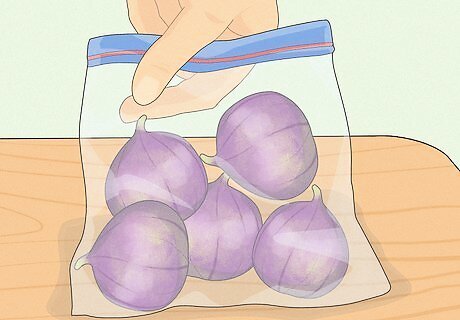
Store ripe figs in a plastic bag and place them in the fridge. Fresh figs are delicate and highly perishable, so try to eat them within 1-2 days of purchase. If you plan to eat them within a day, keep them at room temperature. Otherwise, put them in a ziploc bag in the coldest part of your refrigerator to prevent rotting. The coldest part of the fridge is typically the meat drawer, or the back and bottom shelf. Figs taste best at room temperature, so remove them from the fridge at least 30 minutes before eating them.
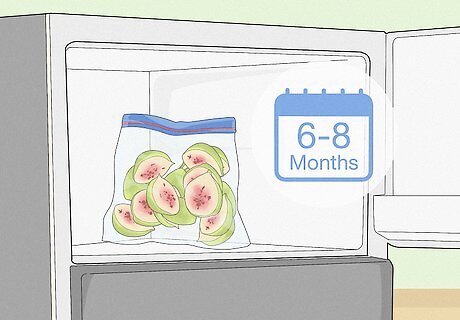
Freeze ripe figs if you can’t consume them within 2-3 days. Preserve your figs by freezing them in ascorbic acid. Just wash 1 US qt (950 mL) of ripe figs in cool water, remove the stems, arrange them on a lined baking sheet, then pop them in the freezer overnight. The next day, put the figs in a freezer-safe container, and stir 0.75 tsp (3 g) of ascorbic acid into 3 tsp (15 mL) of water. Pour this solution over the figs to prevent them from browning. Be sure to consume your frozen figs within 6-8 months for the best results. Unfortunately, frozen figs do not have the same texture or flavor as fresh figs, so substituting them in recipes may alter the final product.
How to Wash & Prepare Figs
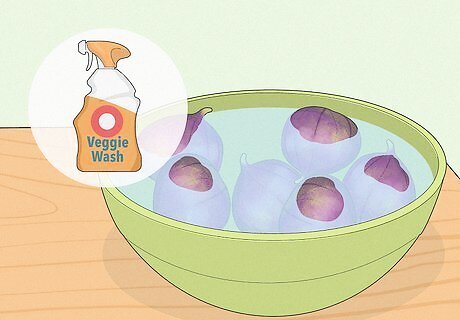
Wash your figs and pat them dry. Rinse the figs under cool water and gently wipe them dry with a clean paper towel. Since figs are delicate, do not scrub them with a vegetable brush. Remove any dirt you see by gently rubbing it off with your fingers. If your figs are really dirty, soak them in a bowl of cool water and veggie wash for 1-2 minutes before rinsing them clean. Before serving the figs, remove the stems by gently twisting them off with your fingers.
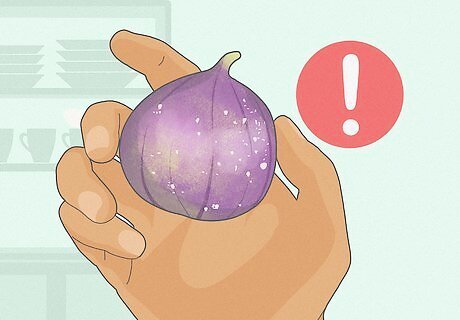
Check for mold or sugar crystals on your figs. Sometimes, figs have a white powder on the outside. This process is called sugaring, and it happens when the natural fruit sugars crystallize on the surface of the fruit. These figs are still good to eat, but many people remove the crystals for presentation or texture purposes. If the white powder looks fuzzy or slimy, it is likely mold so discard the fruit immediately. To remove sugar crystals, pour 1 teaspoon (4.9 mL) of water over 0.5 cup (60 g) of figs, then microwave them on high for 1 minute to dissolve the crystals.
Fig Recipes

Fig toast A popular way to serve fresh figs is to enjoy them raw with a tangy cheese product. Spread goat, ricotta, or cream cheese on a piece of toasted sourdough bread. Then, top with sliced ripe figs and a drizzle of olive oil and honey. Add flaky sea salt to taste. Feel free to sprinkle crushed walnuts or pistachios on top, or add some slices of prosciutto. Choose a sweet and tangy cheese, instead of one that’s sharp. Mascarpone and crème fraiche also pair well with figs. Alternatively, skip the bread. For a quick snack or appetizer, cut the figs in half and place a dollop of plain or flavored cream cheese on top.
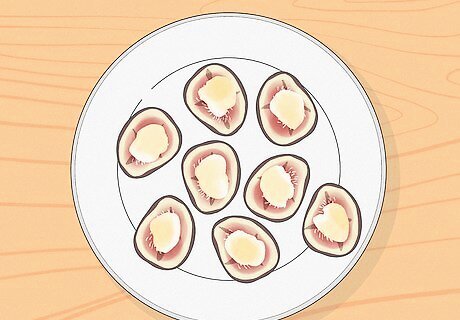
Stuffed figs Remove the stems on the figs, then cut a small “X” on top. Stuff a small ball of goat cheese into the cut and bake for 10 minutes at 400 °F (204 °C). Drizzle with balsamic vinegar and serve immediately. Alternatively, stuff the figs with blue cheese and then top with honey and crushed walnuts.

Fig salad Since figs are sweet, they work well with leafy or slightly bitter greens, like arugula, spinach, radicchio, and endives. Pair them with chopped apples, walnuts, goat cheese, maple syrup, and balsamic vinegar for a taste of fall. Or, marinate the figs in red wine vinaigrette for 30 minutes, before tossing them with mixed greens, goat cheese, and crumbled bacon. Another flavorful combination includes marinated figs, mixed greens, fresh mozzarella, prosciutto, a squeeze of lemon juice, and salt and pepper.

Bacon-wrapped figs Cut the figs in half, wrap each piece with a slice of bacon, and secure with a toothpick. Place the figs seam-side down on a lined baking sheet, then put them under the broiler until the bacon is browned and crispy, about 4-5 minutes per side.
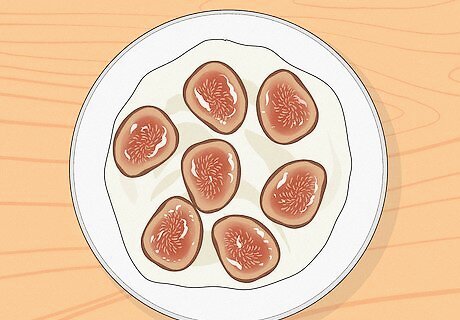
Poached figs To poach fresh figs on the stove, bring a small pot of the poaching liquid to a boil, reduce to a simmer, and cook for 15 minutes. Add the figs and let them simmer for minutes, until they’re soft but not mushy. Remove the figs from the liquid and let them cool, before serving them with yogurt, ice cream, or any other rich dairy product. Use 2 cups (500 mL) of poaching liquid for every 8 figs. For the poaching liquid, try using spiced wine, fruit juice, or flavored vinegar. Alternatively, poach dried figs in wine. Gather 8 oz (230 g) of dried figs, cut the stems, and slice them in half. Combine 0.5 cups (120 mL) of red wine, 0.25 cups (38 g) of sugar, and a dash of salt and pepper in a saucepan. Add the dried figs to the liquid and bring to a boil. Reduce the heat and simmer for 10 minutes.
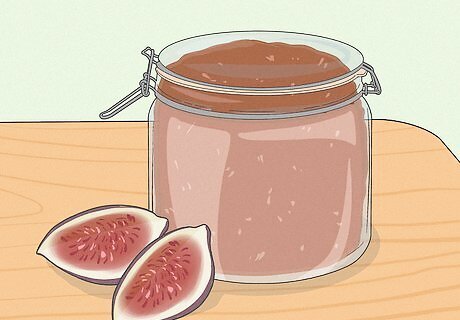
Fig preserves In a large saucepan, pour 3 US quarts (2.8 L) of boiling water over 3 qt (3.8 kg) of fresh figs. Let the mixture stand for 15 minutes, then rinse the figs in cold water and drain. Add 4 cups (800 g) of sugar, 1.5 US quarts (1.4 L) of water, and the juice of 2 lemons in a large pot. Boil for 10 minutes, then carefully drop the figs in the boiling liquid. Cook until the figs are translucent and then remove the figs and place them in sterilized canning jars. Continue boiling the remaining liquid until it’s thick like honey, then pour the syrup over the figs. Let it cool completely and stand in the fridge for 6-8 hours.
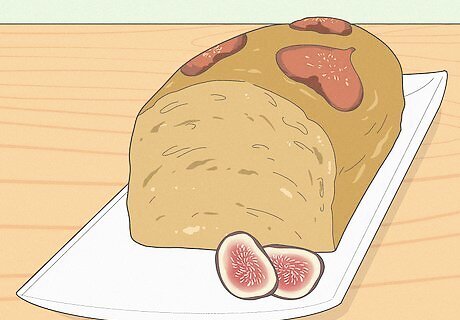
Fig loaf Preheat the oven to 350 °F (177 °C). Mix 3 eggs, 2 cups (400 g) of granulated sugar, 2 cups (400 g) of mashed fresh figs, 0.5 cups (120 mL) of buttermilk, and 0.75 cups (180 mL) of vegetable oil in a bowl. In a separate bowl, mix 3 (600 g) cups of all-purpose flour, 1.5 tsp (6 g) of baking soda, 1 tsp (4 g) of salt, and 0.5 tsp (2 g) of ground cinnamon. Add the wet ingredients to the dry and stir until combined. Pour into a lined loaf pan and bake for 50-60 minutes. If you like, top the loaf with sliced fresh figs and powdered sugar. Feel free to fold chopped walnuts or pecans into the batter before baking.
Cooking with Dried Figs

Rehydrate dried figs. Soak dried figs in water or fruit juice overnight so they become juicier and plumper. Place the dried figs in a shallow dish, then add just enough liquid to cover the layer of figs. In the morning, squeeze the figs to remove excess liquid. Alternatively, rehydrate figs by simmering them in water or fruit juice for several minutes.

Incorporate dried figs in baked goods. Both dried and rehydrated figs work well in breads, cakes, muffins, and cookies. Mix the figs into the wet batter before baking, or use dried figs, instead of other dried fruits, in traditional recipes. Instead of making oatmeal raisin cookies, for example, make oatmeal fig cookies.

Add dried figs to oatmeal or porridge. Another simple way to enjoy dried figs is to sprinkle a few over hot breakfast cereal. The figs will add a mild and sweet boost of flavor.
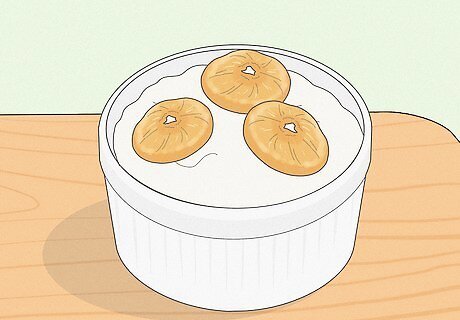
Stir dried figs into cottage cheese or yogurt. For a light lunch, mix a handful of dried figs into one serving of cottage cheese or yogurt. These rich, tangy dairy products complement the taste of figs rather well.
Fig Varieties
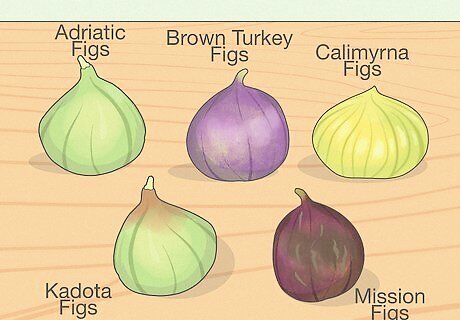
Figs vary in size, color, and flavor, depending on the variety. These differences are fairly subtle, but certain varieties may look more appealing or taste better in certain recipes. Some popular varieties in the United States include: Adriatic figs: Medium in size with pale, yellow-green skin and a pink-red interior. Known for having a more intense flavor than other varieties, especially when dried. Brown Turkey figs: Medium to large in size with purple-brown skin and a red interior. Sometimes referred to as the “Black Spanish” fig. Calimyrna figs: Large with green skin and a bright pink interior. Known for having a nutty, honey-like flavor. Kadota figs: Medium in size with yellow-green skin with a pink-brown interior. Best figs for canning. Mission figs: Dark purple skin and a deep pink interior. Known for being sweet and full of flavor, with a moist and chewy texture.
Health Benefits of Figs
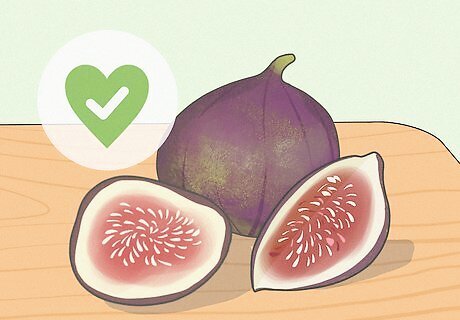
Figs are packed with fiber and protective antioxidants. Figs contain small amounts of calcium, magnesium, and potassium, but the seeds and skin are full of fiber, phenolic acids, and flavonoids. Fiber is great for your digestive health, while phenolic acids and flavonoids may prevent damage caused by free radicals.. A single, small fresh fig consists of: 30 calories 1 g fiber 92.8 mg potassium 0.05 mg manganese 0.02 mg thiamine 0.02 mg riboflavin 0.03 mg copper 0.06 mg vitamin B6 0.8 mg vitamin C 1.9 mcg vitamin K




















Comments
0 comment